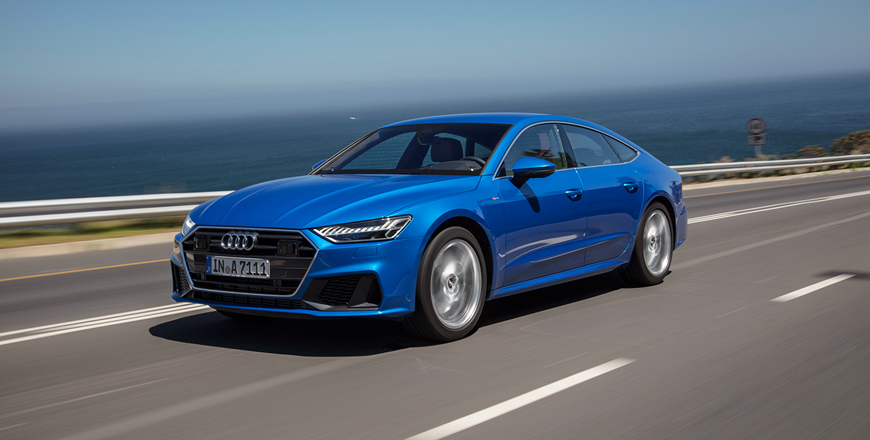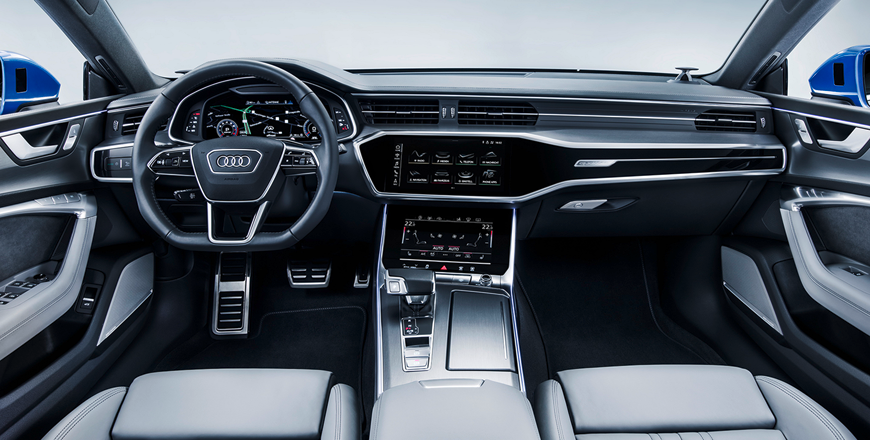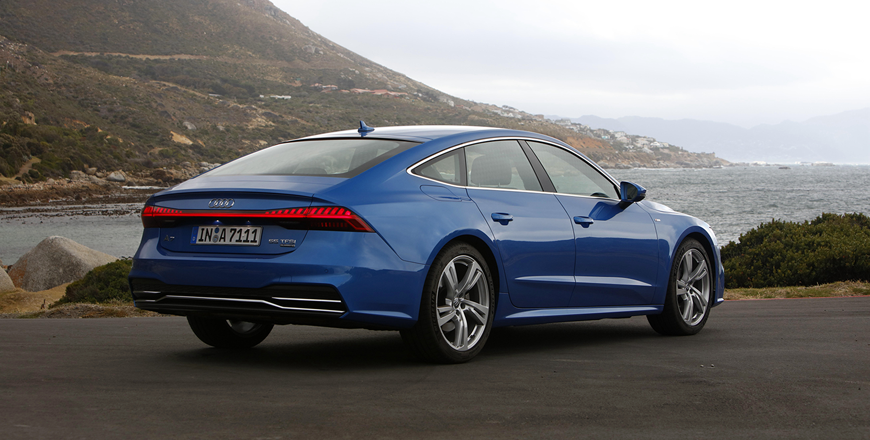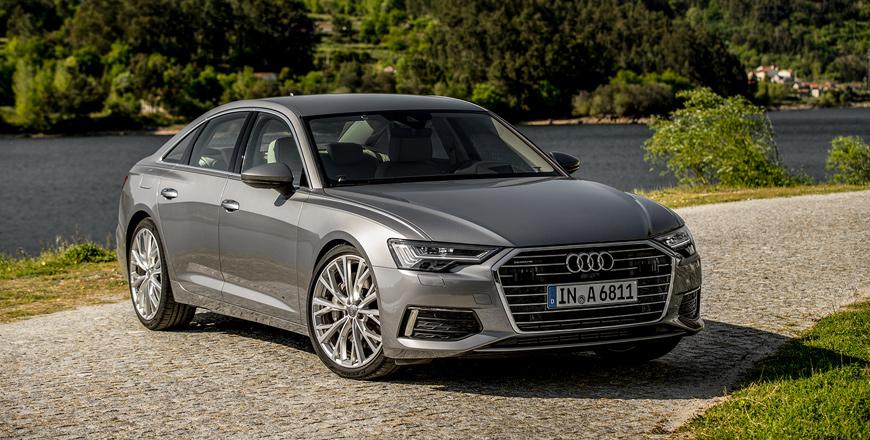You are here
Audi A7 45 TFSI Quattro: Low-slung luxury lift-back
By Ghaith Madadha - Mar 06,2023 - Last updated at Mar 06,2023

Photos courtesy of Audi
First launched in 2010 as the Ingolstadt manufacturer’s dramatic, sure-footed and user-friendly alternative to the fashionable Mercedes-Benz CLS-Class, the sporty, low-slung and upmarket Audi A7 liftback is an even more accomplished car and cohesively flowing design in its second generation.
Introduced in late 2017, the Mk2 Audi A7 is not just a more convincingly premium product that better walks the fine line between practical saloon and stylish grand tourer, and boasts both improved driving dynamics and ride comfort over its predecessor.
New horizon
A competitor to the CLS-Class and the BMW 6-Series Gran Coupe, the Audi A7 is, however, far more than an afterthought based on the A6 executive saloon. Positioned between the A6 and luxury A8 saloons, the A7 instead harks back to the ‘C2’ generation 1977 Audi 100 Avant, which employed a similarly sleek, stylish yet utilitarian lift-back rear hatch design. As a result, the A7 offers better daily drive practicality and boot access than both co-national rivals in a distinctly sportier and more elegantly assertive design.
Shark-like and predatory in demeanour, the long, wide and low slung A7 has an almost nautical design sensibility with its large, bold and upright signature hexagonal Audi grille giving way to a fluently tapered rear deck, along a level waistline with an upward rear kink, and down its long descending roofline. Adopting moody full-width rear lights, the new A7’s design emphasises the horizontal plane, and features slim, heavily browed and scowling headlights, vaguely reminiscent of its distant 100 Avant predecessor’s dramatically deep-set quad headlamps.

Quick confidence
The entry-level petrol four-wheel-drive mode, the A7 45 TFSI Quattro is powered by a turbocharged direct injection 2-litre four-cylinder engine. Positioned just ahead of the front axle, the A7’ slightly nose-heavy architecture is disguised by an elegantly long and defined bonnet, while muscular rear haunches are a subtle callback to the iconic 1980 “Ur” Quattro, and allude to the A7’s grippy four-wheel-drive system, which now employs on a more efficient “Ultra” version that primarily drives the front wheels but responsively re-allocates up to 85 per cent power rearwards when needed.
Developing 241BHP at a 5,250-6,500rpm plateau and 273lb/ft throughout a broad 1,600-4,300rpm range, the A7 45 TFSI Quattro launches briskly but sure-footedly from standstill. With its quick spooling turbo, four-wheel-drive traction and slick and quick-shifting 7-speed dual-clutch automated gearbox, the A7 un-dramatically propels its 1,760kg mass through 0-100km/h in just 6.2-seconds and onto 250km/h. Responsive from low-end and effortlessly flexible in mid-range, it is refined and smooth, with a distant and subdued snarl as it progressively climbs to its peak power band.
Composed and committed
Thoroughly well-equipped with numerous standard and optional high tech infotainment, driver assistance and mechanical systems, the new A7 also features a 48V mild hybrid system that recuperates kinetic braking energy and powers ancillary systems, and allows for longer coasting and improved stop/start functionality, to reduce fuel consumption to a relatively frugal 7.4l/100, combined. The A7’s Quattro Ultra four-wheel-drive meanwhile allows for reduced friction and fuel efficiency improvement. Almost seamless in operation, it can even pre-empt — rather than just respond — when four-wheel-drive is necessary.
Driving all wheels for all-weather confidence and varying power front-to-rear through corners for grip and agility, the A7’s tenacious Quattro four-wheel-drive is renowned for reassuring road-holding and ability to effectively put power down. Sportier and better handling than its predecessor, with its sophisticated all-round five-link suspension, the A7’s quick and direct electric-assisted steering is tidy turning in, and belies its front-biased weighting. A more eager and manoeuvrable drive than to be expected, the A7 is committed, fluent and poised through corners.

Quiet comfort
Composed, capable and effortlessly calm in delivery, whether in town and on the highway, the A7 is in its element through fast sweeping corners, with its superb road-holding and good lateral control. The new A7 is meanwhile a more comfortably forgiving ride than previous, and is supple and smooth on most imperfections, despite its aggressive design and firm low profile tyres. Settled and controlled in vertical movement, the A7 can feel slightly firm over sudden and jagged bumps and potholes.
Quiet and refined with its low CD0.26 aerodynamics, the A7’s hunkered down driving position is, meanwhile, supportive and comfortable, and complemented by user-friendly controls and layouts, a classy, contemporary and well-appointed environment, and a configurable digital instrument panel and twin infotainment screens with haptic feedback. Forgoing some of its saloon sisters’ rear headroom, the A7 is a larger and more spacious car than its predecessor, and can accommodate taller rear passengers, while its practical rear hatch allows easy access to a generous 535-litre boot, which expands to 1,390-litres.
TECHNICAL SPECIFICATIONS
- Engine: 2-litre, turbocharged, in-line 4-cylinders
- Bore x stroke: 82.5 x 92.8mm
- Valve-train: 16-valve, DOHC, direct injection
- Gearbox: 7-speed dual clutch automated, four-wheel-drive
- Ratios: 1st 3.188; 2nd 2.19; 3rd 1.517; 4th 1.057; 5th 0.738; 6th 0.557; 7th 0.433
- Reverse/final drive: 2.75/4.41
- Power, BHP (PS) [kW]: 241 (245) [180] @5250-6,500rpm (estimate)
- Specific power: 121.5BHP/litre
- Power-to-weight: 137BHP/tonne (unladen)
- Torque, lb/ft (Nm): 273 (370) @1,600-4,300rpm
- Specific torque: 186.5Nm/litre
- Torque-to-weight: 210Nm/tonne (unladen)
- 0-100km/h: 6.2-seconds
- Top speed: 250km/h (electronically governed)
- Fuel consumption, combined: 7.4-8.4 litres/100km
- Fuel capacity: 63-litres
- Wheelbase: 2,926mm
- Track, F/R: 1,651/1,637mm
- Aerodynamic drag co-efficient: 0.26
- Luggage volume, min/max: 535-/1,390-litres
- Unladen/kerb weight: 1,760/1,835kg
- Steering: Electric-assisted rack & pinion
- Steering ratio: 15.9:1
- Turning circle: 12.4-metres
- Suspension: Five-link
- Brakes, F/R: Ventilated discs, 338mm/330mm
- Tyres: 245/45R19
Related Articles
Positioned between the A6 executive and A8 luxury saloons in Audi’s model hierarchy, the A7 is, however, a more leftfield design-focused fou
A testament to how time and trends change, the Audi A6 55 TFSI Quattro is a car that would have verged on being a super saloon not all that
Audi’s economy-minded petrol version of its prestigious executive saloon segment, it is testament to how things have changed that the A6 40














